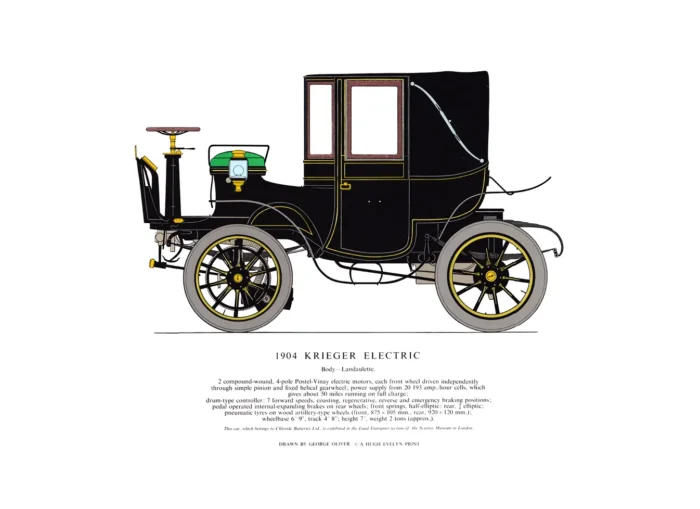1904 Krieger Electric
£25.00
1904 Krieger Electric (scroll down for a more detailed Description)
Published 1966 by © Hugh Evelyn Limited; drawn by George A. Oliver (1920-1990)
Size: c. 47.5 x 34.5 cm [18 ½″ x 13 ½″] – may vary slightly from printers’ cut 50 years ago
Printed on high white matt cardstock weighing 136 g/sm2
Print is LARGE size – shipping is the same for 1 to 10 prints (based on largest print size in your order) – see Shipping & Returns.
In stock
Description
The image you see is a scan which may show some slight distortion of line, fill, colour or text when you expand it. The prints themselves have no distortions.
1904 Krieger electric brougham made by Compagnie Parisienne des Voitures Electriques (precede Krieger) at Courbevoie, Seine, France. In 1894 Louis Antoine Kriéger (1868 – 1951) began designing and building electric automobiles. By 1898 The Brougham, The Landaulet and The Electrolette had been produced. 43 electric vehicles were produced in 1901 and 65 in 1902. They worked with racing vehicles including one called ‘Powerful’ in 1900. Next to either front wheel is an electric motor of 3 hp. The pinion engages with a large gear wheel which is fixed against the wheel. The gear and pinion are encased so each wheel turns independently by its own motor. The 800 pounds of Fulmen batteries are in a box below the carriage and arranged sot it may easily slide out. Kriéger claimed 65 miles on a single charge. The 1700-pound Electrolette on a level grade could do 21 miles an hour, or 12 to 15 miles over an average road. In 1903 Kriéger produced the first hybrid electric vehicle (HEV); it had front wheel drive, power steering and a petrol engine that supplemented the battery pack. LC19 is still in full working order, has a top speed of about 18-20 miles per hour, weighs about 2 tonnes, and can travel about 50 miles when the batteries are fully charged – roughly the same as a modern electric car. This is a drawing of that vehicle held at The Science Museum.
Additional information
| Weight | 0.022 kg |
|---|---|
| Dimensions | 47.5 × 34.5 cm |





